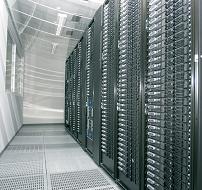Dec 4 2007
The Herkules supercomputer is not only powerful, but also kind to the environment. It consumes considerably less electricity than similar supercomputers. In terms of energy efficiency, it occupies a leading position worldwide.
 Fraunhofer's green supercomputer made up of 272 individual computers.
Fraunhofer's green supercomputer made up of 272 individual computers.
Herkules, the new number-cruncher at the Fraunhofer Institute for Industrial Mathematics ITWM in Kaiserslautern, is not only one of the fastest supercomputers in Germany, but also one of the most efficient. It handles processor-intensive tasks in areas such as simulated reality or computer-assisted engineering, processes seismic data for the oil industry, and calculates costs for automotive, engineering and textile companies.
Herkules “lives” in a new, energy-saving ITWM institute building. The building makes optimum use of daylight and solar heat. Instead of air-conditioning, it uses a smart ventilation system with integrated heat recovery. An efficient combined heat and power unit (CHP) supplies electricity, heating and cooling. For Dr. Franz-Josef Pfreundt, who is head of IT at the ITWM and was in charge of the building activities, the overall “green” concept had to include a low-energy computer center. Working together with computer manufacturers, Pfreundt combined particularly energy-efficient components to create the supercomputer, which has a total of 272 individual computers. These components include thrifty power supply units, power-saving dual-core processors, and device drives with a noticeably lower consumption. In addition, the number of memory modules per computer was reduced to four, which reduces the power requirement even further. “For example, we deliberately chose not to use the very fastest CPUs – microprocessors – for our computer, but those that yield the best performance per watt,” says Pfreundt.
Cooling the server rooms is another way of saving energy. Up to a temperature of 20 degrees Celsius, the rooms are cooled directly with outside air. If it gets too warm, the CHP provides the necessary cooling via an absorption refrigerator. Conversely, on cooler days, the waste heat from the computers is used directly to heat the building. With Herkules, Pfreundt and his colleagues have shown that it is possible to build energy-saving supercomputers that nevertheless have tremendous computing power. At any rate, the Kaiserslautern facility has been assigned place 244 on the Top 500 list of the world’s fastest supercomputers (November 2007). When it comes to the worldwide ecological rankings for supercomputers, Herkules is at place 48. The current winner is IBM’s BlueGene computer, which requires only one watt for 112 million calculating operations, or FLOPS. But Herkules is hard on its heels, with a handsome 100 million FLOPS per watt.